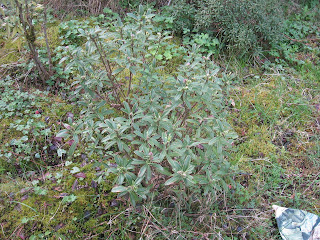I started a program to dig them in summer when dormant and then I replant the area sparsely, and use the extra rhizomes to plant in other beds. Those come up the next year sparsely, but bloom-
They can transform a very weedy grassy bed-
into a delightful patch of flowers that suppress grass, but do best in shade to part shade-
The blue-purple variety 'robinsoniana' is delightful-
As is the frilly variety 'vestal' with a pompom in the center, ethereal but less vigorous, so rarer, than the others-
I surveyed some of my beds that used to be overrun with weeds, some of them are getting close to being filled in sufficiently with successful plants to keep weeds from coming in.
But my long front bed where I killed grass over one winter with newspaper and black plastic had too much exposure to the large lawn area and the irises, roses, daylilies, and fig trees I planted there didn't cover the ground enough to shade out invading grass, so it is a nightmare of reinvasion-
Mulching with newspaper can help a little, here some Ajuga and Columbine are valiantly waging war on weeds for me, maybe they will make it-
Columbines can do a fantastic job of self-sowing, I tried scattering the seeds in the front bed last year-
They are the scalloped leaves with slight purple tints on them mixed in with the Ajuga.
Another ephemeral that I am enjoying is Lunaria annua, the Money Plant. I have 2 colors, white and the usual purple. They sow themselves delicately and like shady places, so are a welcome accent with heart-shaped leaves. And after the seed pods dry out, they make lovely silver dollar-sized shimmering dried floral arrangements. I also learned they have an edible tuber like a parsnip-rooted parsley, and may actually try some out this year.
The white ones are coming up more thickly, but I don't consider either one as problems, they are sedate self-sowers.
Then there is the queen of the native ephemerals, Trilliums, which make a lovely bouquet and have deepened here to a magenta from their initial white.
Then there are the incredibly elegant Bleeding Hearts, which at least here are not in evidence much in the heat of the summer.
And who could forget these blue charmers, which are too aggressive in their exuberance and have to be yanked in late spring because of their decline into grey masses of mildew-
I just love the borage family. I'm not going to go into all the bulbs which fit this category.
Happy gardening, Hannah








































